Canon 20D: Raising the Bar for Prosumer Digital SLRs
by Stephen Caston on November 11, 2004 12:05 AM EST- Posted in
- Digital Camera
The Design: Canon EOS 20D
In most respects, the 20D looks very similar to the 10D. The difference in size is very small. The 20D is 6mm less wide, 1mm shorter, and 3mm skinnier. This, together with the small weight difference, is not really very noticeable - they both feel very similar in our hands. There are a few major design differences and several more subtle contour changes. Click to enlarge. |
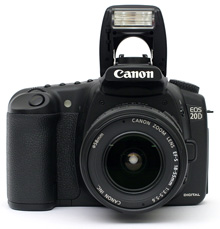 Click to enlarge. |
The front of the 20D features an EF/EF-S lens mount. Support for EF-S lenses is an addition that was seen on the Digital Rebel, but was not available on the 10D. The new EF-S mount was specifically designed to provide a wider angle of coverage for the smaller sensor seen in the Digital Rebel and the 20D. Currently, there are 3 EF-S lenses released by Canon: 18-55mm (kit lens), 17-85mm w/IS (image stabilization), and the 10-22mm. Keep in mind that these EF-S lenses are just additional choices for Digital Rebel and 20D user; they can also choose from any of the numerous EF lenses available. Just to the right of the lens is the Lens Release button. You can remove/change lenses by holding down this button and rotating the lens counterclockwise. On the left side of the camera is the Red-eye reduction/Self-timer lamp. In the image above with the flash raised, we can see that Canon went with the same great decision they made on the Digital Rebel. The flash rises considerably higher than it does on the 10D. This should result in the ability to shoot over larger lenses as well as a reduction in the occurrences of red-eye.
At first glance, the back of the 20D looks very similar to the 10D. However, upon closer inspection, there are some significant changes to notice. Both cameras have 1.8" LCD monitors with 118,000 pixels. Along the left side of both cameras is a column of buttons. In this column, both cameras have the following buttons: Menu, Info., Jump, and Play. The 20D is missing a button that the 10D has: the Direction Switching button. The reason for this absence points us to another major difference between the two. The 20D has added a Multi-controller (to the upper-right of the LCD). The Multi-controller is used to select AF points in record mode and to move across a magnified image in Play mode. It can be pushed in like a button or pushed in 8 different directions (vertical, horizontal, and diagonal). Both cameras feature the Quick Control Dial (seen below the Multi-controller). On the 10D, the Quick Control Dial is used in conjunction with the Direction Switching button to move around magnified images. However, only one axis can be utilized at a time. This means that to move to the upper right portion of an image, you must rotate the dial clockwise, then press the D.S. button, and rotate the dial counterclockwise. With the 20D, this process is simplified with the use of the Multi-controller. To the lower right of the Quick Control Dial is the "Access Lamp", which blinks whenever there is activity (reading or writing) on the flash card. On the 10D, this activity lamp is located on the right side of the camera (on the flash door).
Another main difference lies in the power button. On both cameras, the switch is located in the same position. However, on the 20D there are two positions on the main switch. The first position turns on the camera, but does not enable use of the Quick Control Dial. The second position turns on both the camera and the Quick Control Dial. The 10D offers these two power options as well, but has a separate power switch just for the Quick Control Dial. Again, the 20D offers the same options as the 10D, but in a more simplified manner. The Erase button is located between the power switch and the Play button.
At the upper-right are two buttons. The button on the left is used as an AE/FE lock, Index (in Play mode), and to zoom out while viewing an image in Play mode. The button on the right allows you to select AF points in Record mode and to zoom in on an image in Play mode. The viewfinder displays 9-point AF diamond as opposed to the 10D's 7-point AF cross arrangement. Additionally, the focusing screen has been improved to provide a brighter image and to make manual focusing easier. The viewfinder has a dioptric adjustment wheel to calibrate the focus of the viewfinder. Also, like the 10D, the rubber eyepiece is removable and can be replaced with a fitting on the shoulder strap to block out light during long exposures.
The top of the 20D is nearly identical to the 10D. On the left side is the Mode Dial, which has settings for the 12 different available shooting modes. The 20D's built-in flash raises to a higher level than the 10D's, allowing it to shoot over longer lenses. We should also mention that the 20D is compatible with the new Canon Speedlite 580EX external flash. To the right of the flash are the LCD information panel and 4 buttons. The information panel is very similar to the 10D in that it displays numerous camera settings that can be viewed in a glance. However, the arrangement of the information is quite different. Above the information panel is the "LCD panel illumination button". Pressing this button turns on the backlight for the information panel. The light can be turned off by pressing the button again or by waiting approximately 6 seconds. To the right are the AF mode selection/White balance, Drive mode/ISO speed, and Metering mode/Flash exposure compensation buttons. On the hand grip are the Main Dial and the shutter button. The Main Dial jogs through the choices available for AF mode selection, drive mode, and metering mode.
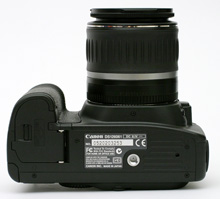 Click to enlarge. |
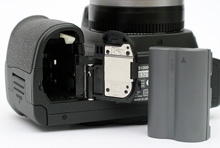 Click to enlarge. |
The bottom of the 20D features a locking hinged door that hides the compartment for the BP-511A Lithium-Ion Rechargeable battery. In addition, a CR2016 battery is now stored in the same compartment (on the 10D it was a CR2025 and was located on the bottom of the camera between the main battery compartment and the tripod mount). A metal tripod mount is located on the 20D in line with the center of the lens.
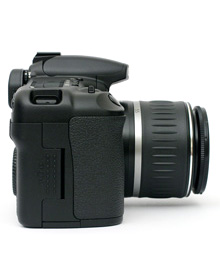 Click to enlarge. |
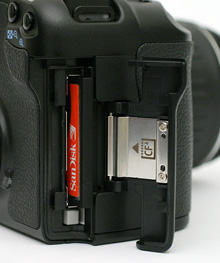 Click to enlarge. |
The right side of the 20D features the same type of sliding hinged door seen on the 10D. The main difference is that the 10D has its "Access Lamp" located on the door, while it is located at the back of the camera on the 20D.
 Click to enlarge. |
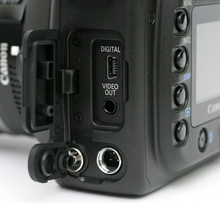 Click to enlarge. |
On the left side of the camera are two small back buttons. The one on the bottom is the depth-of-field preview button. While framing a shot, the camera will use the maximum aperture to allow you to see the brightest image possible. However, pressing this button will cause the camera to step down to whatever the aperture setting is. This allows you to see what the depth-of-field will actually look like in the final picture. The button on the top (above the lens release button) is the flash release button. Pressing this button will cause the flash to pop up and the camera will fire the flash when the shutter button is pressed. Finally, there is a rubber tab that fits into four connectors. The top two connectors are for the USB 2.0 (high-speed) port and the video-out port. Below, this is the PC Sync terminal and the Remote Control terminal.


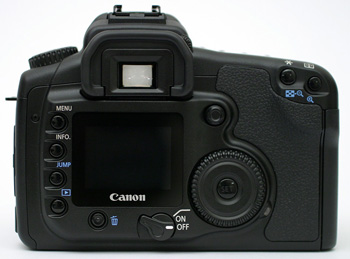
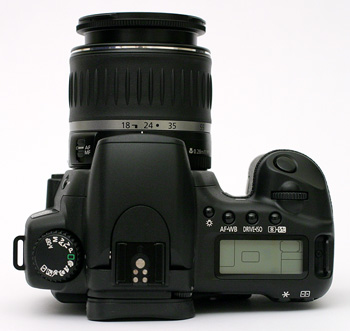








14 Comments
View All Comments
shuttleboi - Monday, November 15, 2004 - link
What exactly is the point of these camera reviews? As I wrote several months ago, Anandtech is a gadget/hardware site, not a photography site. If you want to reach the photography community (like the rich folk who hang around DPReview.com, spending $1000 a month on lenses, and are ready to click on lots of advertisers' banners), you should do something novel. I suggested reviewing portable photo storage devices (e.g. the Epson P-2000, Archos AV-480, and Nikon ), but nobody listened to me. Suit yourself. As soon as you review any of these gadgets, you will find yourself on DPReview.com, gizmodo.com, and other popular sites. But don't listen to me, I'm just a yuppie male, age 28-40, making a good salary; it's not like your advertisers care about my demographic or anything.Joony - Friday, November 12, 2004 - link
I love my 20D, check out my photogallery,http://www.pbase.com/joony
Gatak - Thursday, November 11, 2004 - link
You may also want to look at the DCRAW - Digital Camera RAW. It is a open source program for reading RAW files from most camera RAW files.DCRAW vs. Canon D60: http://www.aim-dtp.net/aim/digicam/dcraw/
DCRAW vs. Canon 10D: http://www.insflug.org/raw/analysis/dcrawvsfvu/
DCRAW source: http://www.cybercom.net/~dcoffin/dcraw/
Windows binary: http://home.arcor.de/benjamin_lebsanft/
stephencaston - Thursday, November 11, 2004 - link
Woodaddy, thanks for your comments. A Canon 50mm f/2.5 Macro lens was used for all the tests except on page 11 (where each picture lists the lens used beneath the thumbnail). I've also amended the other image quality pages to indicate the use of the 50mm. Sorry for this oversight.WooDaddy - Thursday, November 11, 2004 - link
I missed something critical here. Let me know if it was posted. What lens are you using? Since DSLRs have interchangable lenses, the image quality is directly related to the lens used. If not listed, you really want to say that for reference in you image quality tests.#8, #3 I've picked on Stephen when he first got started on his reviews. He's getting better and IMO he's doing a great job. Now mind you, dpreview is for photogs/techies with an emphasis on photogs. AT is the converse; techies/photogs. I would consider ease of use and image quality and control to be a focus in a review at dpreview. Technical features would be the focus at AT....
Personally, I'm a photog more so than a techie camera guy. I'm doing quite well with my Nikon FE2 manual camera (with Acer 2740s film scanner) and Minolta G400 backup.
AtaStrumf - Thursday, November 11, 2004 - link
Wau, this thing makes some great pics! Way too expensive though.Gatak - Thursday, November 11, 2004 - link
#3 Yes dpreview has many good articles. But I think this is a good start anyway. Dpreview is very technical and doesn't really provide much explanation of technical stuff. This is something I think Anandtech could advance in =) It is possible to have technical depth and yet have good, easy to understand explanations.ProviaFan - Thursday, November 11, 2004 - link
#4 - that's why we have the term "prosumer". It's (the 20D) better than consumer, which would be the digital rebel, but it's not in the league of 1D Mark II (even though it has the same resolution, the speed and build quality don't compare) or 1Ds - which are professional.stephencaston - Thursday, November 11, 2004 - link
#4, The 20D is often referred to as a Prosumer camera. Among the reasons are price, 1.6x cropping factor, sealing, built-in flash, and _optional_ battery grip.The 20D is aimed at amateur photographers looking to replace/supplement their existing film SLR or for those looking to upgrade from a non-SLR camera. I've also heard of pros buying 10D and 20D bodies as backup cameras. I don't think it would be fair to the 1D line to call the 20D a professional camera. It is very nice, but not quite pro ;-)
sjprg - Thursday, November 11, 2004 - link
Nice article, I use both a 10D and a 20D and would like to see some ACR tests added to the CPU processing tests besides the emphasis on games to assist us in selecting the best hardware for processing digital images. One of the test that could be used is the Tom Fors ACR calibrator beta 3.http://fors.net/scripts/ACR-Calibrator/